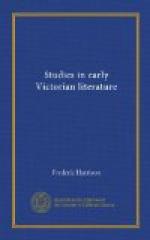His songs, spoiled as they are to our ears by poor music and too often maudlin voices, are as good songs and as fitted for singing as any in our time. The Sands of Dee, hacknied and vulgarised as it is by the banalities of the drawing-room, is really (to use a hacknied and vulgarised phrase) a “haunting” piece of song; and though Ruskin may pronounce “the cruel crawling foam” to be a false use of the pathetic fallacy, the song, for what it professes to be, is certainly a thing to live. I have always felt more kindly toward the East wind since Kingsley’s Welcome, wild North-Easter!; and his Church Hymns such as—Who will say the world is dying? and The Day of the Lord is at hand, at hand!—are far above the level even of the better modern hymns.
We have not yet touched upon Kingsley’s longest and most ambitious poem—The Saint’s Tragedy. With all its merits and beauties it is a mistake. It was avowedly a controversial diatribe against the celibacy and priestcraft of Romanism, and was originally designed to be in prose. That is not a safe basis for a dramatic poem, and the poem suffers from the fact that it is in great part a theological pamphlet. It would have made a most interesting historical novel as a mediaeval pendant to Hypatia; but it is not a great lyrical drama. As we have had no great lyrical drama at all since Manfred and The Cenci, that is not much in its dispraise. There are powerful passages, much poetic grace in the piece; but the four thousand lines of this elaborate polemical poem rather weary us, and a perfervid appeal to the Protestantism and uxoriousness of Britons should have been cast into other moulds.
The long poem of Andromeda almost succeeds in that impossible feat—the revival of the hexameter in English. It may be a hard saying to the countrymen of Longfellow, but the truth is that the hexameter is a metrical monster in our English speech. The paucity of easy dactyls and the absence of all true spondees in English words, the preponderance of consonants over vowels, the want of inflected forms, and other peculiarities in our language—make the hexameter incapable of transplantation; and this magnificent metre loses with us all its majesty, its ease, its beauty. The very line can hardly be printed on an ordinary page, for the immense number of letters in each English verse causes an unsightly doubling of the lines, chokes the voice, and wearies the ear. In the hexameter line of Homer there are usually about thirty letters, of which only twelve are consonants; in the English hexameter there are often sixty letters, of which nearly forty are consonants. And the Homeric hexameter will have six words where the English hexameter has twelve or fourteen.[1] Yet having set himself this utterly hopeless and thankless task, to write English hexameter, Kingsley produced some five hundred lines of Andromeda, which in rhythm, ease, rapidity, and metrical correctness are quite amongst the best in the language. It is very rare to meet with any English hexameter which in rhythm, stress, and prosody is perfectly accurate. Andromeda contains many such lines, as for example:




